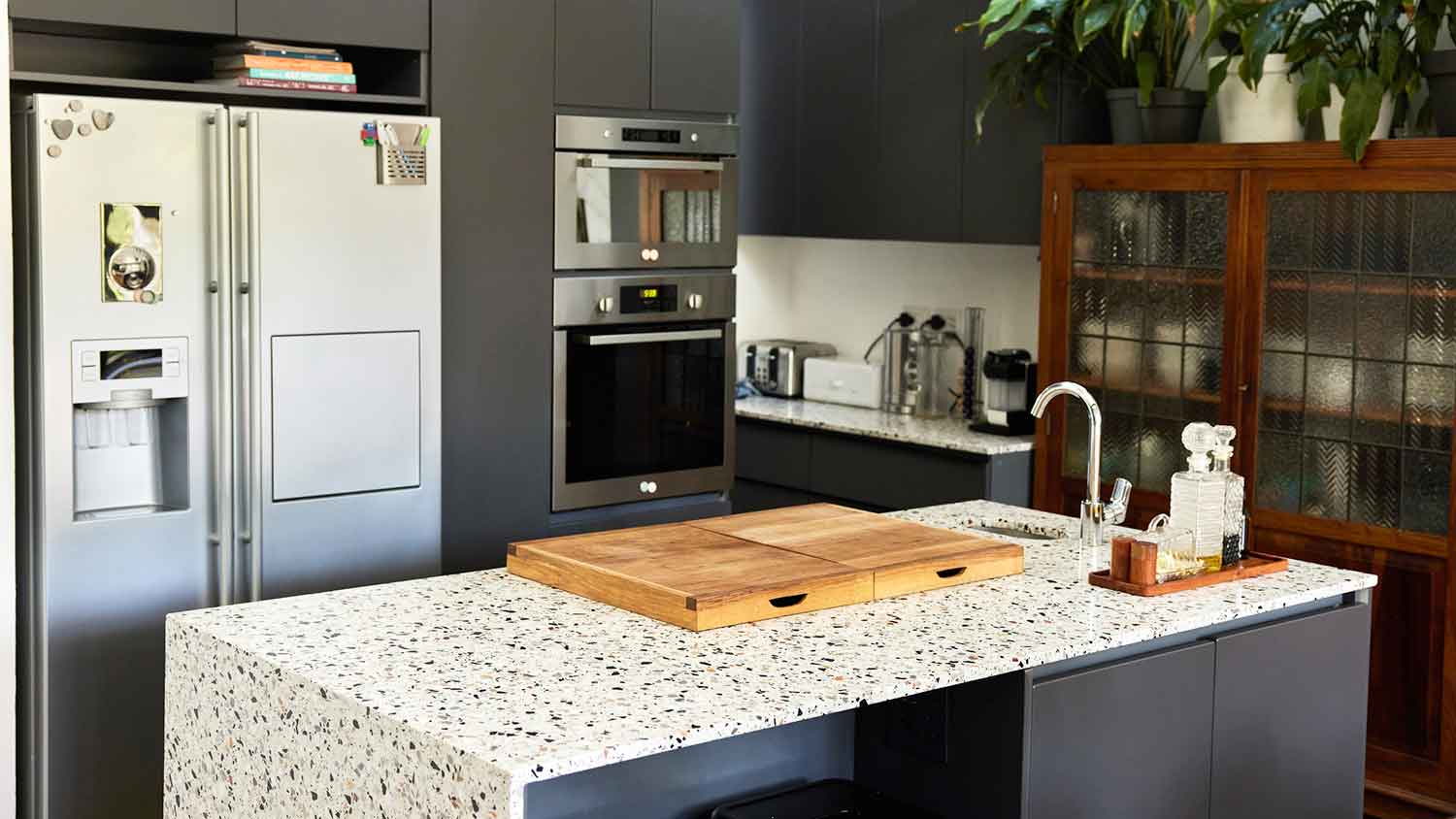
Kitchen islands are multipurpose workhorses in your kitchen. When looking to add one to your home, you should consider its size, materials, and its primary use in your home. Learn about the price of kitchen islands and their different features.
These two sturdy natural stones have some subtle differences to be aware of


Limestone and granite are both highly durable natural stones.
Limestone is softer and more damage-prone but costs less.
Granite is easier to maintain long-term and offers better ROI.
Whether you're remodeling a kitchen or bathroom, one of the biggest decisions is which material to use for countertops. Many homeowners pit limestone vs granite countertops when making this choice. Both are natural stones and are widely available in many colors and patterns. Decisions like these often come down to the details, so we've broken down the key differences.
Limestone and granite are both popular natural stone options for countertops due to their strength. The key differences are in appearance and performance. Limestone is a sedimentary rock that comes in neutral colors like white and black. While strong, it's prone to scratches. Granite is an igneous rock that comes in a wider variety of colors and better resists scratches.

Limestone is a sedimentary rock formed in oceans and caves from fossilized shells and corals. It comes from all over the world, with some of the largest quarries in the U.S. Limestone has a somewhat uniform look, but if you look closely you may see bits of fossilized material embedded within. Colors include whites, grays, tans, taupes, blacks, yellows, and reds.
| Pros | Cons |
|---|---|
| Costs less than granite | Softer and prone to scratches |
| Strong enough for use in kitchens | Does not shine when polished |
| Resists heat damage | Reacts poorly to acidic cleaners |
| Comes in variety of neutral colors | Porous surface stains easily without a seal |
Best for: Those on a budget who still want to add natural materials and value to their home
Limestone is a strong natural stone material that can stand up to the wear and tear of daily use. It also resists heat well, meaning you can place hot pots and pans on it for short periods without worrying about damage.
Limestone is relatively common for a natural stone, with prices ranging from $10 to $70 per square foot. While that's more expensive than some other countertop materials, it's cheaper than granite on average.
Although limited to neutral colors, limestone still offers a variety of options to match the look you want. It's naturally white but can also come in tans, yellows, and taupes. Limestone that's rich in organic material may even appear reddish or black.
Despite its strength, limestone is soft when compared to granite. As such, it's more susceptible to scratches and chips and should be treated more carefully. It also reacts poorly to acidic cleaners, so cleaning materials should be limited to mild soap and water.
Like many natural stone options, limestone has a porous surface that needs to be sealed regularly. Otherwise, it's highly susceptible to stains, especially for liquids as mild as water.
Finally, limestone has a much milder sheen than other natural stones such as granite. This means that even with extensive polishing, you won't be able to achieve a shiny surface.

Granite is an igneous rock, meaning it's formed from cooled, pressurized lava. It's composed mainly of the minerals quartz and feldspar and is most common in mountainous areas. Granite has a speckled appearance and comes in pink, blue, red, gray, white, black, brown, and gold with dark mineral patterns. Let’s look at the pros and cons of granite countertops.
| Pros | Cons |
|---|---|
| Durable and scratch-resistant | Costs more than limestone |
| Comes in neutrals and vivid colors | Cold to the touch |
| Won’t stain when properly sealed | Requires annual sealing |
| High resale value | Usually has multiple seams |
Best for:
Homeowners who want luxury countertops with a high ROI.
Those who want a natural surface that requires less maintenance.
Granite is extremely durable and is not easily scratched or damaged. It is also less prone to staining as long as it's properly sealed at least once per year. This durability, along with its beauty, means that it can significantly increase the value of a home.
Granite is well-liked by designers because of the variety it offers. It comes in a wide range of hues that vary based on the mineral content where it's found. For example, Brazilian granite tends to be black with hints of pink or blue running through it. Granite from other parts of the world may be black, white, gray, reddish brown, or gold.
Granite countertops tend to cost more than limestone at anywhere from $10 to $140 per square foot of material. You'll also likely need to purchase multiple slabs of granite depending on the size of your kitchen, meaning that installation may require one or more seams on the surface.
Although granite is harder and stronger than limestone, it still has a porous surface and requires annual sealing to protect it from stains. Additionally, unlike limestone which conducts heat well, granite absorbs heat and tends to be very cold to the touch as a result.
Let’s compare granite and limestone across a variety of specific categories.
Both granite and limestone are strong enough for use as a countertop material, and both should last a lifetime with proper care. However, granite is technically the stronger stone and won't scratch or chip as easily as limestone.
For the most part, limestone tends to be easier to quarry than granite. As a result, the cost of countertop installation for limestone is lower than for granite. Limestone costs $10 to $70 per square foot, while granite costs $10 to $140 per square foot. There are exceptions, such as choosing a rare limestone that has to be shipped a great distance, which could be pricier than a locally-sourced granite.
If you’re up for the challenge, it’s easier to install granite countertops as a DIY than limestone. Both involve handling extremely heavy slabs of natural stone, but granite is less prone to chipping and scratching. This makes it more forgiving to work with, and mistakes will be less costly if they occur. If you prefer to leave the job to a pro, find a countertop contractor near you.
Both limestone and granite countertops consist of solid pieces of natural stone. It’s possible to repair small chips and even larger cracks in natural stone using epoxy. However, repaired cracks tend to be visible and not aesthetically pleasing, so many homeowners opt for full replacement.
Granite is harder than limestone and stands up well to the wear and tear that kitchen and bathroom countertops experience. Limestone is not only softer than granite but also more porous. This means that it requires extra time and care to clean and maintain. However, both stones require an annual application of sealant for protection.
Both limestone and granite countertops have a very long lifespan, and neither should require replacement within your lifetime after installation. However, it’s worth noting that limestone is softer and more susceptible to damage, meaning it may require replacement sooner if not properly cared for.
Granite offers a better ROI than limestone. Although the cost of granite countertops is higher upfront, granite is a highly sought-after material due to its price point and extremely sturdy composition. Expect to recover up to 25% of your installation cost at the sale of your home.
From average costs to expert advice, get all the answers you need to get your job done.

Kitchen islands are multipurpose workhorses in your kitchen. When looking to add one to your home, you should consider its size, materials, and its primary use in your home. Learn about the price of kitchen islands and their different features.

Discover the cost of installing laminate countertops, including how their size, material, and finish impact your total price.

If you’re looking to refinish your countertops, epoxy will make them shine for years to come. This guide will help you budget for epoxy countertop costs.

Recycled glass countertops are made from discarded glass and a durable binding agent. Learn whether recycled glass countertops are the best choice for you.

Knowing how to cut laminate countertops can help you save money on installation. Just make sure you have the right tools and experience.

Learn about the pros and cons of Dekton countertops to decide if this highly durable material is best for your indoor or outdoor kitchen.